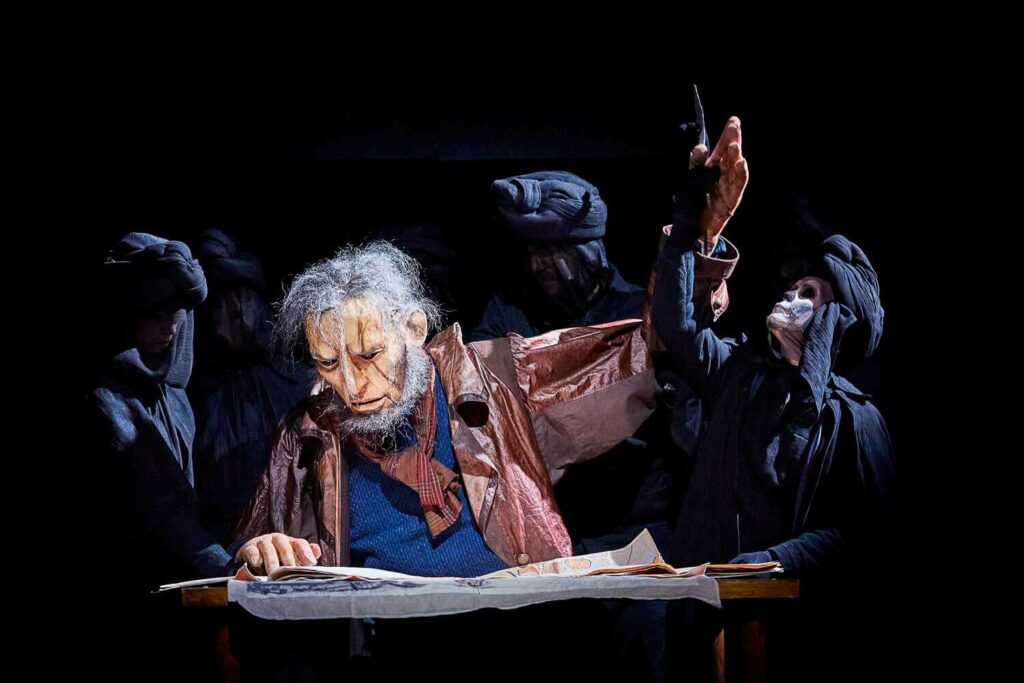
Are You Crazy About Puppets?
First, it was mimes and physical storytellers, then buffoons and puppets – sister-in-law, Norah, and I stumbled into the sweet lap of the Chicago Physical Festival. We had no idea what it was, except for a tiny newspaper ad.

Six years later, we are more educated, more excited, and sometimes more disappointed because we are now old hands at the Chicago Physical Fest and the Chicago International Puppet Festival (CIPF).
If theater is about the suspension of disbelief, then puppetry is a double suspension of disbelief – the story is told not by an actor, but by a doll or costume controlled by a puppeteer. Done well, it works in a magical way. The creative skill of the puppet makers, whether masters of detail or masters of illusion, astounds us. The physical dolls must carry the story line.
There Are All Types of Puppets
We know hand puppets controlled from below (Muppets) and marionettes controlled from above (Howdy Doody). We are less familiar with half-body puppets where the puppeteer wears the top-half of a full-size puppet body and manipulates the arms and face; human and giant-size puppets that are manipulated by several puppeteers dressed in black behind the puppet.
There are tiny bug-sized puppets controlled by strings and sticks with the puppeteer in black on the stage clearly visible. There are huge puppets, think Moby Dick, controlled from above by cables strung to the top of the stage and across to a puppeteer who manipulates via large pulleys. The types go on and on.
Chicago and New York are puppet meccas in the U.S. But puppetry flourishes everywhere. France hosts an international festival in Charleville-Mézièresevery year. Japan is both an ancient and contemporary puppet mecca. And beginning this year, the Chicago International Puppet Festival will appear every January.
This year’s CIPF featured 20 separate troupes at 10 locations spread around the city over two long weekends. There are ancillary workshops, classes and seminars if you want a sheep-dip. We chose five performances. 2023 brought the advent of large puppet productions – full and over-sized puppets in large theaters with music written to accompany the action.
Moby Dick by Plexus Polaire

Of this ilk is Moby Dick produced by Plexus Polaire, a French and Norwegian group featuring seven actors, 50 puppets, video production, an interesting original music score and a very big whale. Impressive, but the play of Moby Dick produced by Lookingglass Theater in 2015 set a standard that won’t soon be overtaken. Ok, so this is puppets. My question is why Moby Dick by puppets. Are we trying to make a molehill out of a mountain? For us, it was a disappointing evening.
Macunaima Gourmet by Pigmaliao Esculture Que Mexe

Another large-scale production is Macunaima Gourmet by the Brazilian troupe Pigmaliao Escultura Que Mexe from Brazil. This is both the origin story and destruction story of the native people of Brazil.
Beginning with the birth of a human baby from the belly of a deer, through his education, manipulation, forced re-creation, and eventual demise, the native Brazilians prosper in their natural environment and then fall prey to the dominant whites who force material garbage – and food – down the native’s throats. Not such a lovely piece and only the tiny scampering ubiquitous leaf-cutter ants represented artistic puppetry to us.
R.A.G.E. by Les Anges au Plafond

Then comes R.A.G.E. from the French troupe Les Anges au Plafond. This is the outlandish story of a successful author who is banned from publication. In revenge, he creates a pseudo-author from his nephew for whom the banned author writes – and he succeeds with the deception.
Way too many plot lines for a puppet show; way too many characters; way too many puppet styles. The music and the foley artist were top drawer, and the puppeteer who manually managed nine 3 x 4-foot panels onto which video was projected, were stellar.
And there was too much dialogue. Usually, puppet shows have few or no spoken lines. Here they had three sets of projected super titles. The crew did not test their effectiveness from various positions in the audience. Many people could not read them.
The performance was in French, the supertitles in English. So, if you could not read the English or understood no French, you quickly lost interest. Too much, done by too many without achieving their intended result.
Dogugaeshi by Basil Twist

Putting the big shows behind us, we reveled in a “new to us” ancient puppet form, Dogugaeshi, produced by New York puppeteer Basil Twist and his company. Though I read a bit about this unique practice of screens on the stage sliding in, off, sideways, breaking apart, coming together, it wasn’t until about 10 minutes into the 60-minute production that I realized the moving screens are the puppets. They tell the story.
It’s a simple story: peace and beauty, followed by earthquake and the screens in shambles, followed by rebuilding, followed by peace and beauty. All told by 60 minutes of sliding screens. Happily, Basil Twist threw in a mythological nine-tailed Chinese fox hand puppet as sop for audience members like me dying for a taste of Japanese traditional puppets.
The music was amazing. The Japanese play string instruments toned to a different scale than Western string instruments. It took a good te10n minutes for my ear to adjust. The string players, Yumiko Tanada and Yuko Reinkano Kimura played the three-stringer shamisen and the multi-stringed zither-like Koto. Spellbinding.
After the performance, we were invited behind the stage to see the 12 sets of tracks on which the panels reside and slide. Size from the floor of the frames are about 12 feet tall and 16 feet wide. Lots of running and scooting by the puppeteers to produce a seamless effect.
Frankenstein by Manual Cinema

And last is my favorite puppet troupe, Manual Cinema, from Chicago. They did Frankenstein, in their tradition shadow puppet mode. For years, the essence of puppetry was to create a magical space where puppets filled the stage and puppeteers were never seen. Manual Cinema shows how they make the sausage.
The “stage” is a jumbo white screen that hangs above the stage onto which the show is projected. On the stage, we see all the puppeteers running between props and projectors and costume. It should be a madhouse, but they never run into each other, rarely trip, and our eyes are torn between the show above and the show below.
Manual Cinema is frequently touring, so check their website and plan accordingly. You won’t be disappointed – and take the grandchildren.
Don’t be put off because Norah and I didn’t love every performance. That’s all part of the learning process. Next year, we will stick to the smaller venues. Join us in Chicago next year, January 18-28, 2024.
Click here for information about CIPF’s Spring Workshops – some online and some in person. Scroll down and subscribe to their newsletter so you receive ticket information for 2024.
Let’s Have a Conversation:
When was the last time you went to see a puppet show? What play was it? What was the puppet style? Did you like it? Do you have a favorite puppet troupe?
Tags Entertainment





